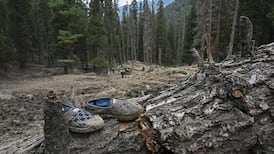Fresh ice avalanches struck on a perilous route where 16 Everest sherpas were killed last week, hiking officials said today, making it almost certain that no one will summit the world's highest mountain from Nepal during this year's climbing season.
“Teams are leaving, it’s over for all,” said leading climber Alan Arnette on his website. “Time to mourn and regroup.”
Many expeditions abandoned base camp this week after an April 18th avalanche killed 16 guides who were cracking ice and fixing ropes on the upper reaches of the Khumbu Icefall.
The single deadliest disaster on the 8,850-metre Himalayan mountain, the incident has shocked the mountaineering community and highlighted the disproportionate risks that Nepali guides run for a few thousand dollars to help foreign climbers reach the summit.
Californian mountain guide Adrian Ballinger said that even before the latest avalanches, there had been an exodus of teams from base camp due to the aggressive behaviour of a group of younger sherpas there.
He said these sherpas were determined to ensure no one scaled Everest from the south side during this year’s climbing season, which ends around May 25th. It would be the first year of no summits since commercial climbs took off in the mid-1990s, though there will be attempts on the north side from Tibet.
"I could see fresh avalanches falling at the same spot that was hit last week," Ang Tshering Sherpa of the Nepal Mountaineering Association (NMA) said in Kathmandu after returning from base camp. No one was hurt in the latest avalanches as there was no one on the unstable Khumbu Icefall.
Ed Marzec, a 67-year-old Californian who had hoped to become the oldest American to scale Everest, said there was a “crack” of ice as he was waiting yesterday for a plane to take him off base camp.
“The sherpas say the ice conditions have changed so much and so rapidly, they have created extremely dangerous conditions which prevent finding a safe route to the summit,” he said in comments emailed by his friend, Daniel Beer.
Too few sherpas
Mr Ballinger told Reuters by phone from Kathmandu that when he left base camp early yesterday afternoon there were only 40-50 climbers still there hoping to make an ascent. They had a similar number of sherpas, though even they had gone to villages lower down because they felt threatened by other guides.
About a week ago there had been more than 600 people there.
Two big teams that were still holding out yesterday later declared their expeditions were over, Mr Arnette said.
Tilakram Pandey, an official at Nepal’s mountaineering department, said the so-called Icefall Doctors, who are responsible for making routes through the glacier up to Camp 1, would repair the trail for those who wanted to climb.
But Mr Ballinger said that with so few sherpas left, it would be virtually impossible to set out.
“You need this critical mass of people to keep digging and putting the route back in,” he said. “Non-professional recreational climbers ... just don’t have the power to push through those conditions without significant sherpa support.”
The government said yesterday it would allow those who pull out after the disaster to return without paying extra fees for permits within five years.
The tragedy has provoked criticism that the government takes hefty fees for climbing permits but does little for the guides themselves. This week it gave in to demands from the sherpas to pay compensation to the families of those killed and to raise the minimum insurance cover for guides.
Guiding foreign climbers is the main livelihood for sherpas, helping them make up to $8,000 (€5,800) or more each year in a country with an average annual income of just over $700.










